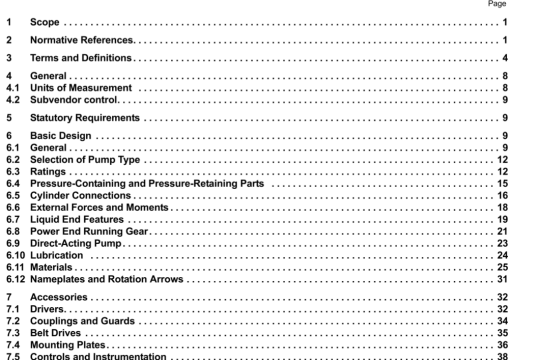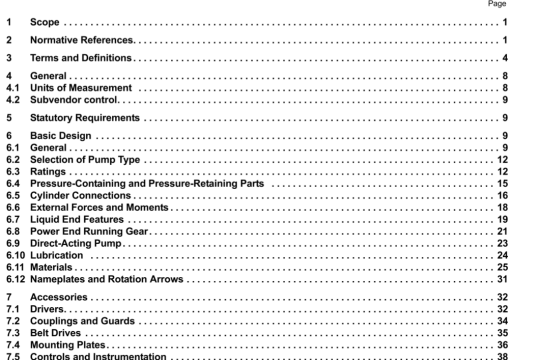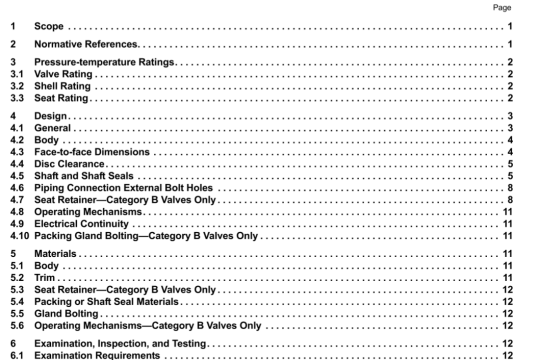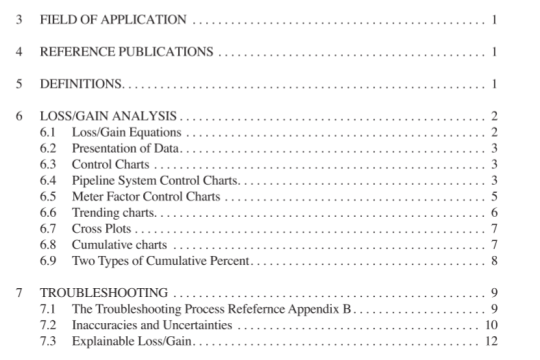API RP 2001:2019 pdf download
API RP 2001:2019 pdf download.Fire Protection in Refineries.
6.2.2.5 Fire Water Flow Duration
The total water supply within the refinery should be capable of supplying the maximum flow for a period of not less than four to six hours, consistent with projected fire scenario needs. Where the water system Is supplied from a tank or reservoirs, the quantity of water required for fire protection should be reserved exclusively for fire protection. However, where the tank or reservoir Is automatically filled by a line from a reliable, separate supply, such as from a public water system or wells, the total quantity in storage may be reduced by the Incoming fill rate.
6.2.2.6 Water Requirements for Tank Fires
Full surface tank fires represent large water demands for fire suppression. Pro-incident planning should consider water sources and delivery to the fire. This may involve high-capacity foam monitors, Large diameter hose (LDH) and high-capacity mobile pumps. API 2021 discusses tank fire suppression with water-foam solution needs indicated in Figure 5 from that standard (see Figure 2).
Recent testing of new foam formulations (see 6.3.1) has revealed there may be a need to increase the application rate from historical values, particularly when fluorine free foam concentrates are used. Consult your foam supplier andlor NFPA 11, for additional guidance specifIc to the foam concentrate being used.
b) main fire pumps that are operated, either manually or automatically, to provide the basic capacity;
C) pumps in standby service to provide water in the event of failure or demand exceeding the capacity of other pumps.
6.2.4 Fire Hydrants
The type of fire hydrant used will depend upon climatic conditions. Standard self-draining fire hydrants meeting the Aniencan Water Wor1is Association standards are generally used in freezing climates.
Fire water supply manifolds can be used instead of fire hydrants in nonfreezing dimates Fire hydrants or headers can Include a variety of outlets, Including large steamer or hose connectlons Hose connections should be compatible with those used on the hoses of the local fire department and mutual-aid organization, or adequate adapters should be provided.
The number of hydrants in an area Is usually determined by the design and type of process. The normal distance between fire hydrants ranges from 150 ft to 300 ft (45 m to 90 m), depending on the fire hazard, layout of the area, water requirements, and the number of outlets on the hydrants. The distance between a fire hydrant and a building or structure that is to be protected should be at least 50 ft (15 m), if possible.
6.2.5 Fire Hose and Reels
Fire hose may be categoazed as attack hose or supply hose. Traditionally most refineries have used 2 ‘I in., 1 in., and 1 in. hose as their standard for attack hose. LDHs (from 4 in., 5 in., and 6 in. in diameter up to lOi’ in.) have growing acceptance and appbcation as supply hoses. Coordination of hose fittings and connections with local mutual-aid or public resources is appropriate irrespective of the sizes of hose used.
The 2 V2 in. attack hose is used primarily for heavy cooling streams. Three or more people are required to handle 2 in. hose lines, depending upon the system pressure. Two ‘/ in. hose lines are suitable to supply water for small portable ground monitors, It is general practice to carry this hose on mobile equipment to reduce plant hose requirements. Some 1 in. or 1 ‘i in. hose is usually carried on the mobile equipment for use in tank farms or other outlying areas.
LDH is used to supply high-flow mobile monitors such as used for tank fire suppression or for water supply to
areas where a system is too small, compromised or nonexistent. In some cases. LDH provides advantages because:
a) its tower fnction loss reduces pumping resource requirements.
b) it minimizes personnel staffing requirements by reducing the need for multiple hose lays (one 5 in. LDH may carry as much water as six 2 ‘2 in. hoses),
c) it facilitates the use of high flow rate monitors used for tank firefighting.
For rapid availability of water in process areas, permanently connected hose reels and hose stations have been used extensively. These reels are usually provided with a 1 ‘1 in. or 1 ‘I in. hard rubber or comparably sized fabric hose for incipient firet’lghting. The hard rubber hose on a continuous floW reel has the advantage that it can be charged and used by one person without unreeling it entirely. However, its use is limited because hydraulic pressure loss limits the length of hose to —100 ft (3D m) to assure adequate nozzle pressures. Fixed fire monitors are often used rn conjunction with hose reels in many new facilities. Hose reels stations may be configured to provide foam for rapid response to leaks or spills.
6.2.6 Nozzles
Combination fire hose nozzles provding water patterns continuously variable from straight streams to water spray (or water tog) are widely used.




